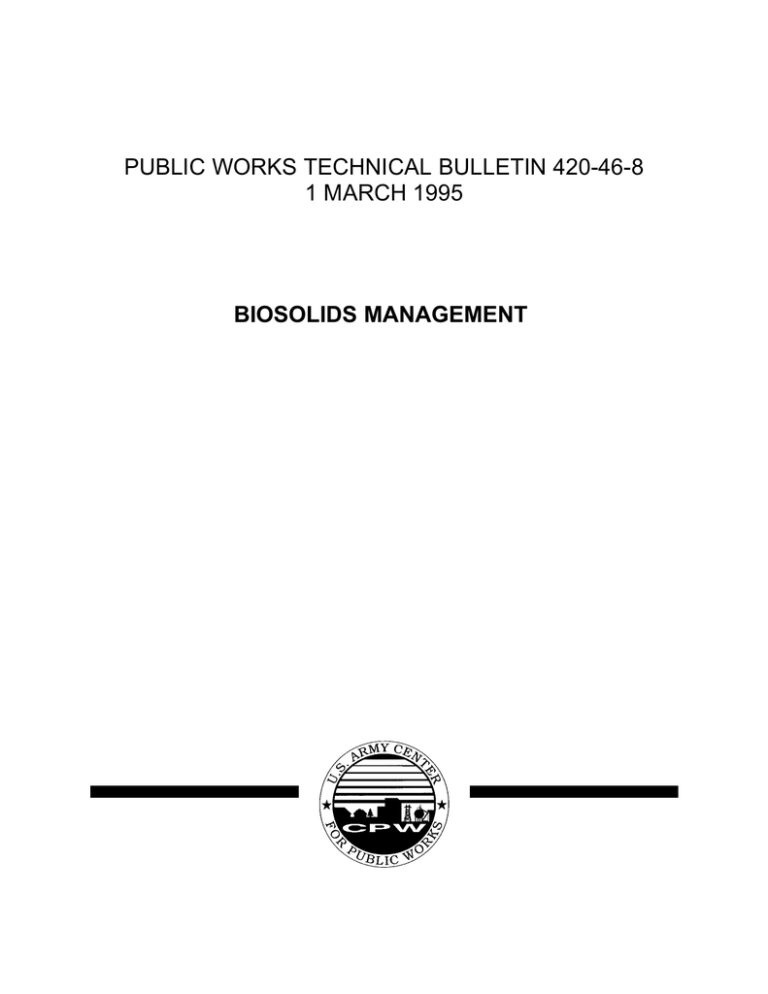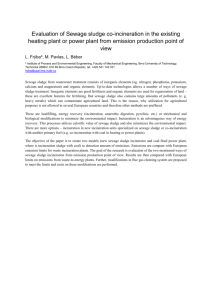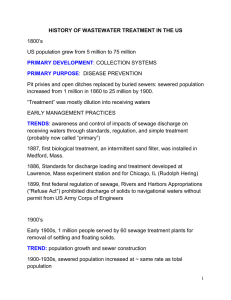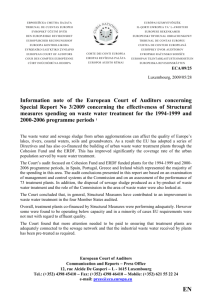PUBLIC WORKS TECHNICAL BULLETIN 420-46-8 1 MARCH 1995 BIOSOLIDS MANAGEMENT
advertisement

PUBLIC WORKS TECHNICAL BULLETIN 420-46-8 1 MARCH 1995 BIOSOLIDS MANAGEMENT Public Works Technical Bulletins are published by the US Army Center for Public Works, Alexandria, VA. They are intended to provide information on specific topics in areas of Facilities Engineering and Public Works. They are not intended to establish new DA policy. DEPARTMENT OF THE ARMY US Army Center for Public Works 7701 Telegraph Road Alexandria, VA 22315-3862 Public Works Technical Bulletin No. 420-46-8 1 March 1995 FACILITIES ENGINEERING Utilities BIOSOLIDS MANAGEMENT 1. Purpose. The purpose of this Public Works Technical Bulletin (PWTB) is to transmit The US Environmental Protection Agency (EPA) Plain English Guide to the EPA Part 503 Biosolids Rule (September 1994). This EPA publication provides an easy to read explanation of the requirements of Part 503 in informal and understandable language. 2. Applicability. This PWTB applies to all US Army Facilities Engineering/Public Works activities. 3. References. a. AR 420-46, Water Supply and Wastewater, 1 May 1992. b. Public Law 100-4, Clean Water Quality Act (CWA) of 1987. c. Title 40, Code of Federal Regulations (CFR), Part 503, The Standards for the Use or Disposal of Sewage Sludge; published in the Federal Register (58 FR 9248 to 9404) on 19 February 1993. 4. Discussion. a. AR 420-46 prescribes policy, responsibilities, and procedures for operating wastewater treatment facilities in a manner that protects public health and the environment. b. The EPA has published comprehensive sewage sludge regulations required by the 1987 amendments to the Clean Water Act. The enclosed EPA Plain English Guide for the recently promulgated Biosolids Rule (40 CFR 503) will assist in the understanding of the complex and self-implementing requirements for biosolids management. Additional copies of the EPA Guide can be obtained from the EPA National Center for Environmental Publications & Information, Post Office Box 42419, Cincinnati, OH 45242-2419, commercial phone: (513) 891-6561. PWTB 420-46-8 1 March 1995 c. The 40 CFR 503 applies to sludge (biosolids) generated from the treatment of domestic wastewater and includes domestic septage. Disposing of biosolids and other wastewater solids in municipal solid waste landfills may continue providing such practices comply with 40 CFR 258, Criteria for Municipal Solid Waste Landfills. The person that prepares the biosolids and other wastewater solids must insure compliance. d. The beneficial use of biosolids is promoted by 40 CFR 503. Producers of high quality biosolids are encouraged to market their products as fertilizer. Management standards for handling and the use of biosolids are also established. e. The 40 CFR 503 rule is comprehensive, setting standards for land application, surface disposal and incineration practices. For each of these practices, the rule addresses applicability and special definitions, such as operational requirements, management practices, monitoring, record keeping, and reporting requirements. f. The enclosed Plain English Guide to the EPA Part 503 is intended as a helpful tool for interpretation and implementation of 40 CFR 503; it must not be used as a substitute for the actual 40 CFR 503 language. Common questions and answers to help understand 40 CFR 503 appear at end of each chapter. An additional resource for answers to questions may be obtained by using the list of EPA regional and State coordinators, located at appendix B of the enclosed guide. g. Additional information about the development of 40 CFR 503 is located in the Preamble to the 40 CFR 503, published in the Federal Register (58 FR 9248 to 9404) on 19 February 1993. h. Special terms applicable to biosolids management are explained in the enclosed glossary. 5. Point of Contact. Technical guidance and/or questions on biosolids management, beneficial use, privatization and regionilization should be directed to US Army Center for Public Works, CECPW-ES, 7701 Telegraph Road, Alexandria, VA 22315-3862, at DSN 656-5194, commercial (703) 806-5194 or PAXID CPWES. FOR THE DIRECTOR: FRANK J. SCHMID, P.E. Director of Engineering 2 PWTB 420-46-8 1 March 1995 This publication may be reproduced. PWTB 420-46-8 1 March 1995 GLOSSARY Active sewage sludge unit - A sewage sludge unit that has not closed. Animals - Domestic livestock. Annual Pollutant Loading Rate (APLR) - The maximum amount of a pollutant that can be applied to a unit area of land during a 365 day period. Annual Whole Sludge Application Rate (AWSAR) - The maximum amount of sewage sludge (dry weight basis) that can be applied to a unit area of land during a 365 day period. Aquifer - A geologic formation, group of geologic formations, or a portion of a geologic formation capable of yielding quantities of ground water to wells or springs. Agronomic rate - The whole sludge application rate (dry weight basis) designed to: a. provide the amount of nitrogen needed by the food crop, feed crop, fiber crop, cover crop, or vegetation grown on the land; and b. minimize the amount of nitrogen in the sewage sludge that passes below the root zone of the crop or vegetation grown on the land to the ground water. Biosolids - Primarily an organic solid product generated by domestic wastewater treatment processes that can be beneficially recycled. Bulk sewage sludge - Sewage sludge that is not sold or given away in a bag or other container for application to the land. Clean Water Act (CWA) - Formerly referred to as either the Federal Water Pollution Act or the Federal Water Pollution Control Act Amendments of 1972, Public Law (PL) 92-500; as amended by PL 95-217, PL 95-576, PL 96-483, PL 97-117, and PL 100-4. Comprehensive State Ground Water Protection Program (CSGWPP) - A group of strategic activities endorsed by EPA that establish a common ground water protection goal across programs; establish priorities based on resource characterization and identification Glossary 1 PWTB 420-46-8 1 March 1995 of ground water contamination sources; define roles and responsibilities; implement efforts to accomplish the State's ground water protection goal and priorities; coordinate information collection and management; and provide for public education and participation. A CSGWPP includes, among other things, a system for determining different uses of ground water including use as an underground source of drinking water or use supporting an aquatic ecosystem. Contaminate an aquifer - Introducing a substance that causes the Maximum Contaminant Level (MCL) for nitrate-nitrogen in 40 CFR 141.11 to be exceeded in ground water or that causes the existing concentration of nitrate-nitrogen in ground water to increase if the existing concentration of nitrate-nitrogen in the ground water exceeds the MCL for nitrate-nitrogen in 40 CFR 141.11. Composite sludge sample - A sample taken either in a wastewater treatment process, dewatering facility, or application device consisting of a series of individual grab samples. For liquid sludges, a minimum of three grab samples of 500 milliliters taken during the first one-third, second one-third and final one-third of a pumping cycle and combined in equal volumetric amounts. For semi-dewatered, dewatered or dried sludge, a composite sample consisting of a minimum of three grab samples of 0.5 pounds taken over a period of 24 hours not less than two hours apart. Cover - Soil or other material used to cover sewage sludge placed on an active sewage sludge unit. Cover crop - A small grain crop, such as oats, wheat, or barley, not grown for harvest. Cumulative Pollutant Loading Rate (CPLR) - The maximum amount of an inorganic pollutant that can be applied to an area of land. Daily maximum ("Daily max") - The maximum value allowable in any single sample or instantaneous measurement. Displacement - The relative movement of any two sides of a fault measured in any direction. Domestic septage - The liquid or solid material removed from a septic tank, cesspool, portable toilet, type III marine sanitation device, or a similar treatment works that receives only domestic sewage. Domestic sewage - Waste and wastewater from human or household Glossary 2 PWTB 420-46-8 1 March 1995 operations that is discharged to or otherwise enters a treatment works. Dry weight basis - Calculated results based on a dry weight measured after heating to 105 degrees Celsius until a constant mass is reached (i.e., 100 percent solids content or zero percent moisture). Fault - A fracture or zone of fractures in any materials along which strata on one side are displaced with respect to strata on the other side. Feed crops - Crops produced primarily for consumption by animals. Fiber crops - Crops such as flax and cotton. Final cover - The last layer of soil or other material placed on a sewage sludge unit at closure. Food crops - Crops consumed by humans. These include, but are not limited to, fruits, vegetables, and tobacco. Forest - A tract of land thick with trees and underbrush. Grab sample - A single "dip and take" sample collected, to comply with monitoring requirements, at a representative point anywhere in wastewater treatment or surface disposal processes. Grit and screenings - Sand, gravel, cinders, other materials with a high specific gravity and relatively large materials such as rags generated during preliminary treatment of domestic sewage at a treatment works. Must be disposed of according to 40 CFR 258. Ground water - Water below the land surface in the saturated zone. Industrial wastewater - Wastewater generated in a commercial or industrial process. Instantaneous measurement - A single reading, observation, or measurement to comply with monitoring requirements. Land application - The spraying or spreading of sewage sludge onto the land surface; the injection of sewage sludge below the land surface; or the incorporation of sewage sludge into the soil so that the sewage sludge can either condition the soil or Glossary 3 PWTB 420-46-8 1 March 1995 fertilize crops or vegetation grown in the soil. Leachate collection system - A system or device installed immediately above a liner that is designed, constructed, maintained and operated to collect and remove leachate from a sewage sludge unit. Liner - Soil or synthetic material that has a hydraulic conductivity of 1 x 10-7 centimeters per second or less. Liquid sludge - A sludge having a dry weight solids content less than or equal to 8% of the total weight of the sludge. Lower explosive limit for methane gas - The lowest percentage of methane gas in air, by volume, that propagates a flame at 25 degrees Celsius and atmospheric pressure. Monofill - A landfill that receives only sewage sludge. Non-public contact site - Agricultural land, forests, and reclamation sites. Pasture - Land on which animals feed directly on feed crops such as legumes, grasses, grain stubble, or stover. Pathogen - An organism that is capable of producing an infection or disease in a susceptible host. Permitting authority - Either the EPA or a State with an EPAapproved sludge management program. Person - An individual, association, partnership, corporation, municipality, State or Federal agency, or an agent or employee thereof. Person who prepares sewage sludge - Either the person who generates sewage sludge during the treatment of domestic sewage in a treatment works or the person who derives a material from sewage sludge. Processes to Further Reduce Pathogens (PFRP) - A process capable of composting, heat drying, heat treatment, thermophilic aerobic digestion, irradiation or pasteurization. Pollutant - A pollutant is an organic substance, an inorganic substance, a combination of organic and inorganic substances, or pathogenic organisms that, after discharge and upon exposure, Glossary 4 PWTB 420-46-8 1 March 1995 ingestions, inhalation, or assimilation into an organism either directly from the environment or indirectly by ingestion through the food-chain, could, on the basis of information available to the Administrator of EPA, cause death, disease, behavioral abnormalities, cancer, genetic mutations, physiological malfunctions (including malfunction in reproduction), or physical deformations in either organisms or offspring of the organisms. Pollutant Limit - A numerical value that describes the maximum amount of a pollutant allowed per unit amount of sewage sludge (e.g., milligrams per kilogram of total solids); the maximum amount of a pollutant that can be applied to a unit area of land (e.g., pounds per acre); the maximum density of a microorganism per unit amount of sewage sludge (e.g., most probable number per gram of total solids); the maximum volume of a material that can be applied to a unit area of land (e.g., gallons per acre); or the maximum amount of pollutant allowed in plant tissue (e.g., parts per million). Processes to Significantly Reduce Pathogens (PSRP) - A process that consists of aerobic digestion, air drying, anaerobic digestion, composting, or lime stabilization. Public contact site - Land with a high potential for contact by the public. This includes, but is not limited to, public parks, ball fields, cemeteries, plant nurseries, turf farms, and golf courses. Qualified ground water scientist - An individual with a baccalaureate or postgraduate degree in the natural sciences or engineering who has sufficient training and experience in ground water hydrology and related fields, as may be demonstrated by State registration, professional certification, or completion of accredited university programs, to make sound professional judgements regarding ground water monitoring, pollutant fate and transport and corrective action. Range land - Open land with indigenous vegetation. Reclamation site - Drastically disturbed land that is reclaimed using sewage sludge. This includes, but is not limited to, strip mines and construction sites. Runoff - Rainwater, leachate, or other liquid that drains overland on any part of a land surface and runs off of the land surface. Glossary 5 PWTB 420-46-8 1 March 1995 Seismic impact zone - An area that has a 10 percent or greater probability that the horizontal ground level acceleration or the rock in the area exceeds 0.10 gravity once in 250 years. Sewage sludge - Solid, semi-solid, or liquid residue generated during the treatment of domestic sewage and/or a combination of domestic sewage and industrial waste of a liquid nature in a treatment works, sewage sludge includes, but is not limited to, domestic septage; scum or solids removed in primary, secondary, or advanced wastewater treatment processes; and a material derived from sewage sludge. Sewage sludge does not include ash generated during the incineration of sewage sludge or grit and screenings generated during preliminary treatment of domestic sewage in a treatment works. Sewage sludge unit - An area of land on which only sewage sludge is placed for final disposal. This does not include land on which sewage sludge is placed for either storage or treatment. Land does not include waters of the United States as defined in 40 CFR 122.2. Sewage sludge unit boundary - The outermost perimeter of a sewage sludge unit. Specific Oxygen Uptake Rate (SOUR) - The mass of oxygen consumed per unit time per unit mass of total solids (dry weight basis) in the sewage sludge. Surface disposal site - An area of land that contains one or more active sewage sludge units. Total solids - The materials in the sewage sludge that remain as residue if the sludge is dried at 103 to 105 degrees Celsius. Treatment works - Either Federally owned, publicly owned, or privately owned devices or systems used to treat (including recycle and reclamation) either domestic sewage or a combination of domestic sewage and industrial waste of a liquid nature. Unstabilized solids - Organic materials in sewage sludge that have not been treated in either an aerobic or anaerobic treatment process. Unstable area - An area of land subject to natural or human-induced forces that may damage the structural components of an active sewage sludge unit. This includes, but is not limited Glossary 6 PWTB 420-46-8 1 March 1995 to, land on which the soils are subject to mass movement. Vector attraction - The characteristic of sewage sludge that attracts rodents, flies, mosquitos or other organisms capable of transporting infectious agents. Volatile solids - The amount of the total solids in sewage sludge lost when the sludge is combusted at 550 degrees Celsius in the presence of excess air. Glossary 7 PWTB 420-46-8 1 March 1995 EPA/625/R-92/013, Control of Pathogens and Vector Attraction in Sewage Sludge, Dec 92. EPA/831-B-93-002a, Preparing Sewage Sludge for Land Application or Surface Disposal, Aug 93. EPA/831-B-93-002c, Surface Disposal of Sewage Sludge, May 94. EPA/832-B-92-005, Domestic Septage Regulatory Guidance, Sep 93. Glossary 8






![Self-supply treatment & disposal register [Year] [A Wastewater](http://s3.studylib.net/store/data/006661037_1-a87e10c3ed3f726a249f6a80d49c5650-300x300.png)